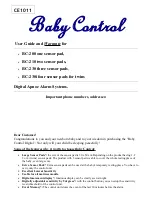
ENGLISH
15
E
Troubleshooting
Before calling for repair services, make sure following checks
for possible remedies to the encountered symptoms.
There is no picture or sound.
• Is the power cord disconnected? (See page 12.)
• Is the main power switch set to “OFF”? (See page 14.)
• Is the monitor in standby mode (the power LED illuminating
in orange)? (See page 14.)
• Make sure correct input mode is selected.
• If any external equipment is connected, make sure the
equipment is operating (playing back).
Remote control does not work.
• Are the batteries inserted with polarity (+,-) aligned? (See
page 12.)
• Are the batteries exhausted? (See page 12.)
• Point the remote control unit toward the monitor’s remote
control sensor. (See page 12.)
• Is the menu display hidden or is operation disabled? (See
Operation guide.)
Sound from left and right speakers is reversed.
Sound is heard from only one side.
• Are audio cables connected properly? (See pages 10 and
11.)
• Make sure audio cables for external speakers are
connected properly: left and right cables may be reversed
or one of the two cables may not be connected. (See page
11.)
• Check the setting of BALANCE under AUDIO in the MODE
SELECT 1 menu. (See Operation guide.)
There is a picture but no sound.
• Is the sound muted?
• Make sure the volume is not set to minimum.
• Is the PC audio cable (commercially available) connected?
• Are audio cables connected properly?
• Is the audio signal input properly to the audio input terminal
corresponding to the selected video input terminal?
Unstable video.
• The signal may be incompatible.
• Try the automatic screen adjustment when the PC analog
RGB input terminal or the PC analog RGB input terminals
(BNC) is used.
Control buttons do not work.
There is no picture.
• Some kind of load noises from outside might interfere with
normal operation. Turn off the power and turn it on after
waiting at least 5 seconds, and then check the operation.
The monitor sometimes makes a cracking sound.
• You may hear cracking sound from the monitor. This
happens when the cabinet slightly expands and contracts
according to change in temperature. This does not affect
the monitor’s performance.
Power LED flashes red.
• Fan error. Turn off the monitor and request repair from your
SHARP dealer.
The power LED is flashing in red and green alternately.
When “TEMPERATURE” is displayed in the corner of the
screen.
• When the internal temperature of the monitor rises
excessively, the fan starts operating, and the brightness
of the backlight automatically decreases in order to
prevent a further temperature rise. When this occurs,
“TEMPERATURE” is displayed on the screen and the
power LED flashes red and green alternately. (When TEMP
ALERT under FUNCTION 1 is set to OSD&LED. This
varies depending on the setting.)
(In this case, brightness settings cannot be adjusted.)
• If the internal temperature rises further, the monitor
automatically enters standby mode. (The power LED
continues flashing red and green alternately.)
• Remove the cause of the excessive temperature rise.
- If the monitor enters standby mode due to a rise in
temperature, to return to normal display, turn the power off
and then back on again. The monitor, however, will enter
standby mode again if the cause of the temperature rise
is not eliminated. (See page 9.)
- Check whether the monitor is placed at a location where
a quick rise in temperature is likely. Internal temperature
rises quickly if the vents on the monitor are blocked.
- Internal temperature rises quickly if dust accumulates
inside the monitor or around the vents. Remove dust if
possible. Ask Sharp dealer about removing internal dust.
Summary of Contents for PN-425
Page 75: ......
















































